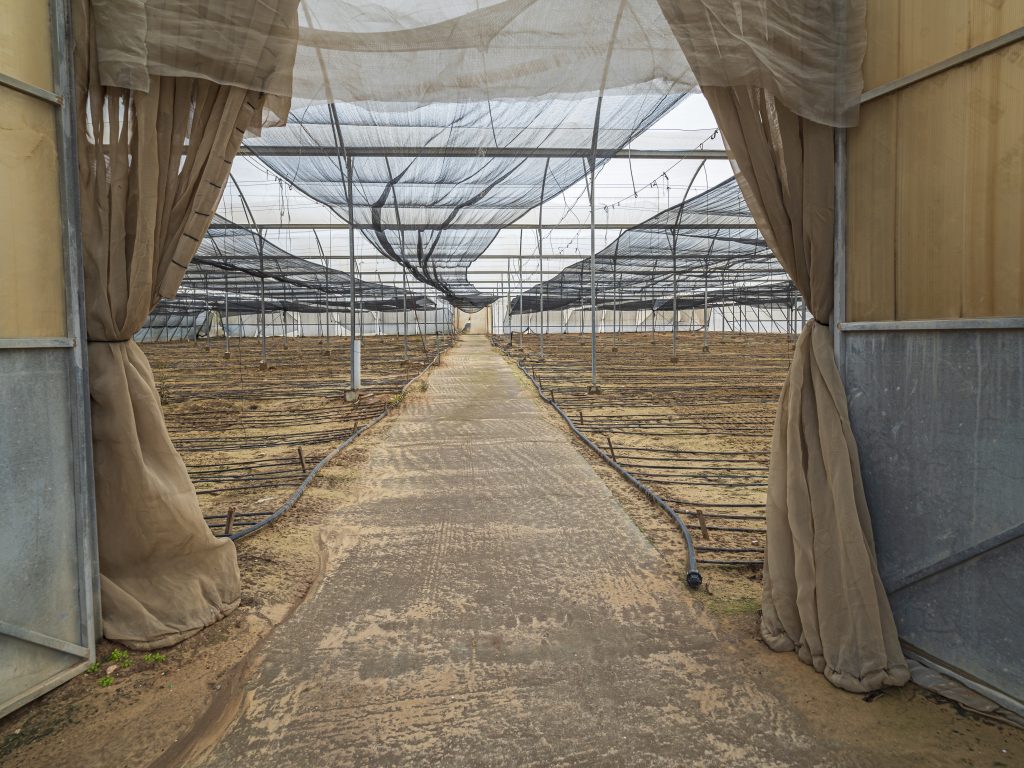Shemitah Up Close: The Heroism of Israeli Farmers
There are many nuances regarding the observance of shemitah that are informed by halachah; at times a farmer’s ideology might influence his approach as well. Jewish Action writer Toby Klein Greenwald interviewed four farmers, all formerly of Gush Katif, who today farm in various parts of the country. Each of the farmers keeps shemitah in a different way, yet they all share a passion for farming and a deep love of the Land.
Anita Tucker
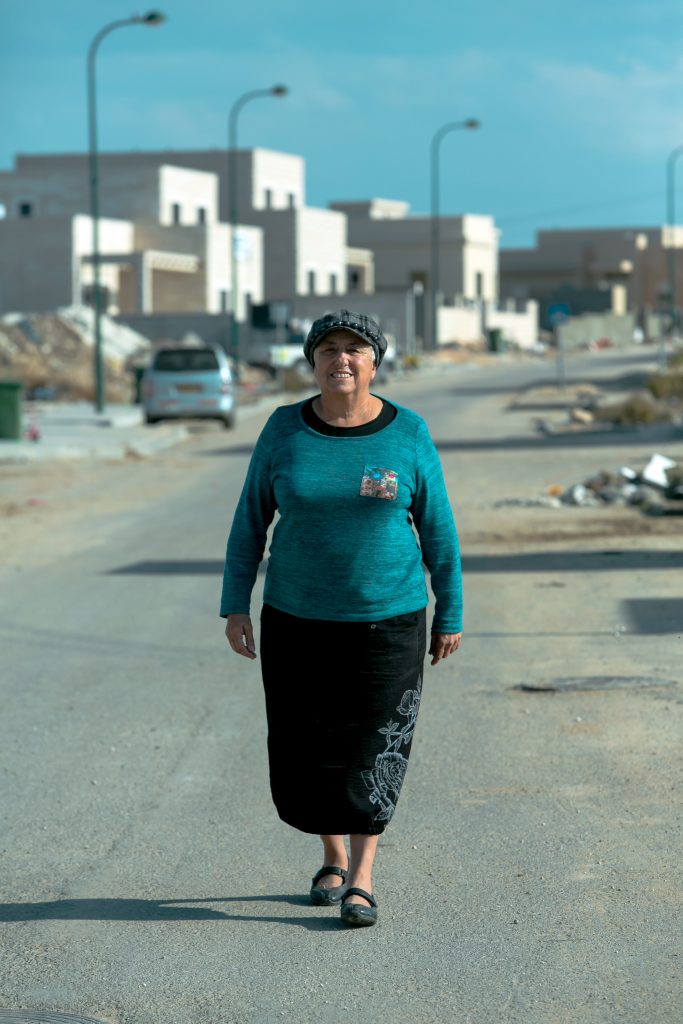
“Being a farmer is a way of life . . . . planting in and of itself is an act of faith.”
The Tuckers, along with eighteen other farmers in the newly established Netzer Hazani moshav in Central Israel, are not farming for the duration of the shemitah year. Photo: Sasson Tiram Photography
Even in egalitarian Israel, Anita Tucker—a female farmer—is an anomaly.
Anita became an iconic figure when she lived in Netzer Hazani, a settlement in Gush Katif, where she was known as “the celery lady” because of the bug-free organic celery she grew in large greenhouses. Additionally, she served as a leading spokesperson for the struggle against the Disengagement, which ultimately destroyed her two-and-a half acres of celery-growing hothouses.
Today Anita, seventy-six, and her husband Stuart, seventy-nine, are part of a collective farm in the newly established Netzer Hazani moshav in central Israel. (Re-established after the uprooting of Gush Katif with the same name, Netzer Hazani is located near Moshav Yesodot, to the east of Ashdod.) In this collective farm, a company is hired to do the actual physical work, tending to large fields of onions, cauliflower and other vegetables. This year, however, the Tuckers, along with eighteen other farmers in the moshav, are not farming. “We decided to ‘mashmit’ the land—let it lie fallow,” she says.
Preparing in advance for shemitah, Anita’s husband, a biology teacher, has been teaching more hours in a local high school to assist with the finances. Anita has no pension from the successful organic farm she lost in Gush Katif. And despite the fact that the Tuckers won’t be farming, they still have to pay fees to the land authorities and taxes to the farming collective, she explains. (Most agricultural land in Israel belongs to the Israel Land Authority, which leases the land to the farmers.)
Shemitah in Gush Katif
The Tuckers, who moved to Gush Katif in 1976 and helped found the first of three farming moshavim there, grew “almost every vegetable and flower you can think of, switching crops according to the demands of the export market,” she says.
“We grew kosher insect-free lettuce. I began experimenting with cabbage and parsley, which were successful, and each year we tried growing more leafy vegetables. In the last few years we were there, we developed an expertise in growing insect-free celery.”
The couple was finally profiting from their investments in building hothouses on the sand dunes of Gush Katif. “But everything was cut short by the expulsion,” says Tucker, “and during the following seven years of wandering [after the expulsion, the Tuckers moved from a youth hostel to a yeshivah dorm to a temporary caravan in Ein Tzurim], we spent most of our savings.”
During the first shemitah in Gush Katif some forty years ago, Rabbi Shlomo Goren ruled that the area was not considered within the halachic boundaries of Eretz Yisrael. “Even the more Chareidi hechsherim certified us that year,” she says. By the time the second shemitah in Gush Katif came around, Israel’s Chief Rabbinate ruled that there was a “safek,” a doubt regarding the status of the land. So the Tuckers decided to grow crops in accordance with the shemitah laws.
They grew produce detached from the ground and in greenhouses with a roof. They used flowerpots that had drain holes on the side instead of at the bottom, and they lined the floors of the greenhouses with thick plastic sheeting to ensure that the produce did not derive any nourishment from the ground. (This method is known as matza menutak, literally, “detached platform.”) According to many authorities, vegetables grown in this manner are exempt from shemitah restrictions.
This shemitah cycle, says Tucker, is the first time she merited to own land where there are no doubts regarding its status. “Jews living outside of Israel can’t have that zechut. I hope they’ll come on aliyah.”
With regard to eating fruits and vegetables during the shemitah year, the Tuckers try to only buy “produce with kedushat shevi’it” (fruits and vegetables that have reached a certain stage of growth during shemitah, which have a special holiness). Indeed, according to some halachic opinions, there is a positive mitzvah to consume such produce.
Managing Financially
While their farming income nowadays is significantly less than when they farmed in Gush Katif—it brings in approximately NIS 2,500 a month (about $793) before land and co-op taxes—Tucker is grateful for this supplemental income.
During shemitah, while the land lies fallow, she is hopeful that they will get some financial help from the Keren HaShemitah, a private fund that supports shemitah-observant farmers. “Still, in spite of the financial challenge,” she says, “we feel it is an amazing zechut to be able to mashmit our land.”
Farming is also a way for Tucker to connect to the land. “We farm for the additional income but also as an expression of our love of Eretz Yisrael, to see it flourish as promised.
“Being a farmer is a way of life,” she adds. “Some years you can make more and some years less, but planting in and of itself is an act of faith. [In the Talmud], Masechet Zera’im is referred to as ‘Masechet Emunah,’ the ‘Tractate of Faith.’”
Eliyahu Saban
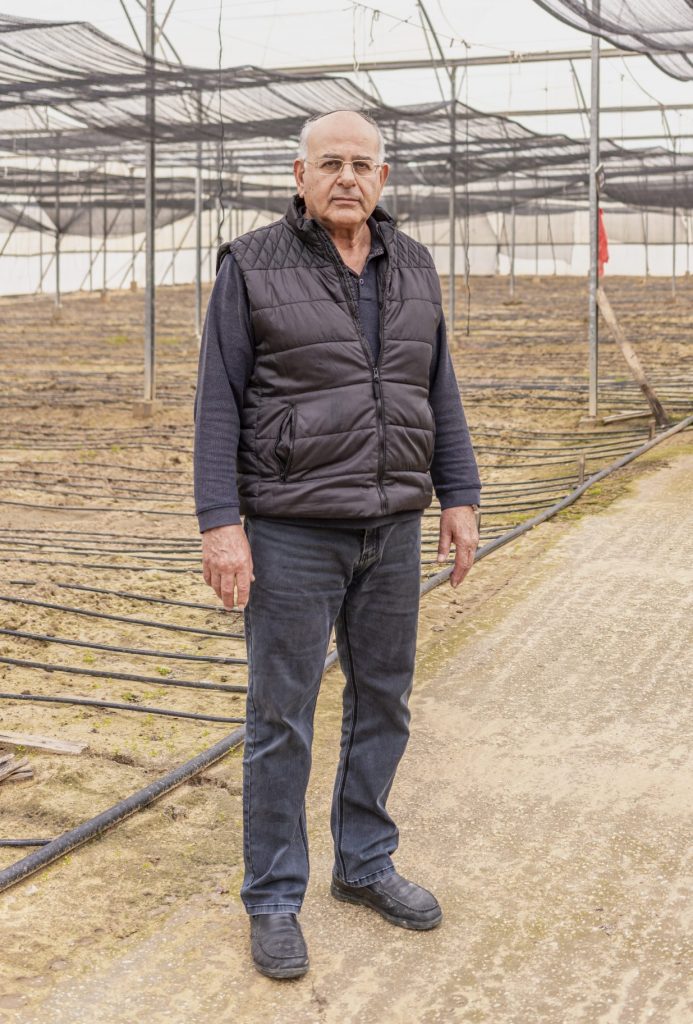
“If you keep shemitah and you believe that’s what you’re supposed to do, then the Creator takes care of you.”
Saban is not working his land during shemitah. Photo: Rebecca Kowalsky
This past erev Rosh Hashanah, Eliyahu Saban turned off the main water valve that irrigates the vegetables he grows in thirty-five glorious dunams (about eight and a half acres) of hothouses. Eliyahu, like the Tuckers, is not working his land during shemitah.
“I keep the mitzvah of ‘Shabbat laHashem,’ and the land rests,” he says.
Saban’s farm is located in southern Israel, in Be’er Ganim, a village north of Ashkelon that was created for the residents of Moshav Gadid, the religious Bnei Akiva moshav in Gush Katif, and eight other Gush Katif communities, though it opened its doors to others as well. For twenty-three years, Saban lived in Moshav Gadid, where he was one of the growers of the famous bugless lettuce, which he continues to grow in Be’er Ganim.
“Today there is a huge market for bugless lettuce. Even those who are not Torah-observant want to eat this kind of lettuce, because they know it’s healthier, as there is such strict regulation regarding the use of pesticides,” says Saban. “The Ministry of Agriculture checks the fields, and post-production they check packages on supermarket shelves for pesticide residue. For this reason, the farmers are afraid to spray more than they should.”
How does Saban spend all of his free time this year with no farming work keeping him busy?
“I’m learning more Torah and I work at a slower pace, which this year means upgrading things around the farm, such as the water system, the screens, and other things that are not connected to the earth itself. I come home and learn Torah again, as it says, ‘Vehagita bo yomam valailah’—one must study during the day and night. I’m having a wonderful time.”
Chazal describe those who observe shemitah as “mighty in strength, gibborei ko’ach.” This is because giving up one’s livelihood for a full year requires an extraordinary level of mesirut nefesh.
Saban says he is managing financially. “You have to let the land lie fallow with full emunah,” he explains. “I understand when people say it’s difficult. I say whoever keeps the Torah as it’s written by the Creator of the World should do so sincerely, not because he thinks he will get [compensation] from the Ministry of Agriculture or from American donors. When I sat with the Ministry of Agriculture representative, I told him, ‘I don’t want to know how much compensation I’ll get. Even if I don’t get one shekel, I’m going to let the land rest.’ I tell my friends who are farmers: ‘If you do it for the money, don’t do shemitah. Don’t you think the Creator knows what’s in your heart? You need to do it because this is what’s written in the Torah.’ Every time I keep shemitah—and this is the fifth shemitah cycle I am not working the land—I see more and more blessing. If you keep shemitah and you believe that’s what you’re supposed to do, then the Creator takes care of you and there will be blessing.”
David Ben Saadon
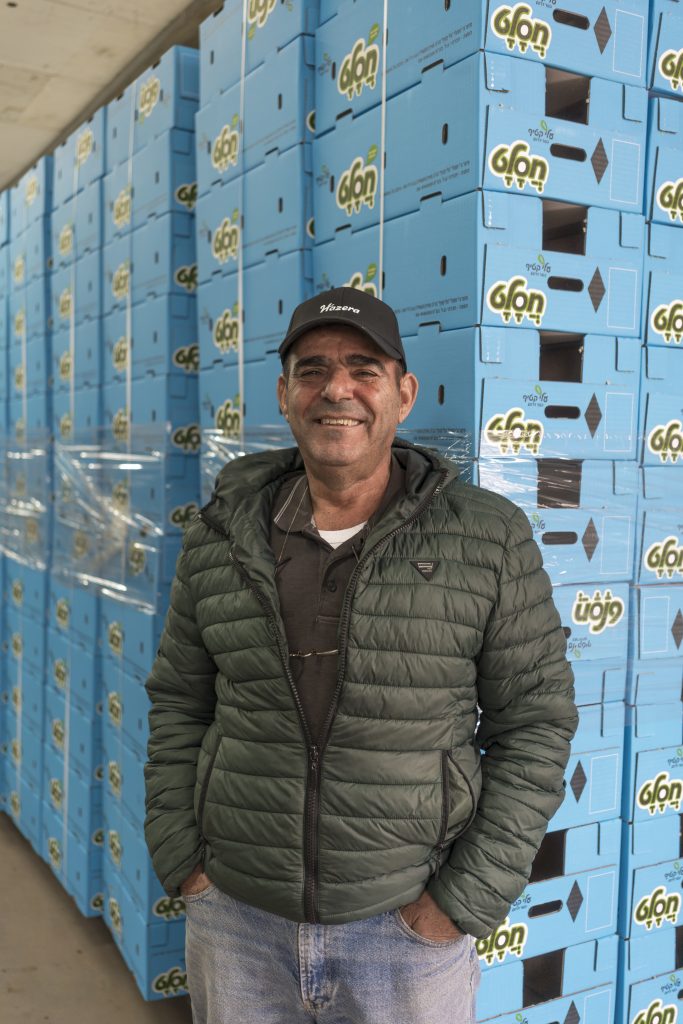
“My son and I do not work; it is assur [forbidden].”
Ben Saadon owns a farm in Zikim. Photo: Rebecca Kowalsky
David Ben Saadon always loved agriculture. As a teen he studied in an agricultural high school and subsequently, in 1978, he was involved in establishing Moshav Gadid where he learned how to grow insect-free lettuce. Today he grows lettuce for the Chasalat-Alei Katif company on a farm in Zikim, a kibbutz south of Ashkelon. Chasalat-Alei Katif is the largest insect-free vegetable company in Israel.
After the destruction of Gush Katif, when Ben Saadon was forced out of Moshav Gadid, he did not receive enough financial help from the Israeli government to recoup his losses. So he moved to South America, where he set up a farm in the Dominican Republic. “I had 450 dunams there, and we exported produce to the US and Canada. I would fly back and forth to Israel to see my family,” he says. “After almost six years I returned to Israel and my family was still living in prefab ‘caravillot’ [caravans] in Nitzan.”
In 2010, he returned to live in Israel and established the farm in Zikim, where he works now, growing high-quality lettuce. “All of Am Yisrael eats my produce; we have kashrut mehuderet.”
The laws of shemitah apply only to produce grown within the boundaries of Eretz Yisrael. Exactly where the boundaries extend is a matter of halachic controversy. Some authorities rule that anything grown south of Ashkelon (including Gush Katif) is outside the boundaries of Eretz Yisrael. Others extend the boundaries well into part of the Negev desert (east of Nachal Arava) until Eilat. Zikim—which is south of Ashkelon—is in an area considered “kibbush Olei Mitzrayim” [within the borders created by the Israelites who left Egypt and entered the Land of Israel with Yehoshua].
According to the Mishnah, when the Jews returned to Eretz Yisrael from Bavel after seventy years, the areas in which they settled and which Ezra sanctified regained their kedushah and are referred to as kibbush Olei Bavel.
The laws of shemitah are only partially binding in parts of the country that were conquered by Yehoshua (kibbush Olei Mitzrayim) but were not reconquered by Ezra.
Ben Saadon’s lettuce is under the supervision of Otzar Ha’aretz, an organization that seeks to advance the proper observance of shemitah through overseeing an otzar beit din and other initiatives, and to strengthen Jewish agriculture. During shemitah, Ben Saadon sells his land to a non-Jew in a transaction known as “heter mechirah l’chumrah.” Rav Moshe Baraness, who oversees all the Otzar Ha’aretz produce, explains: “We were required [in Ben Saadon’s area, considered kibbush Olei Mitzrayim] by the rabbanim of Otzar Ha’aretz and also according to the directives of Rav Shlomo Zalman Auerbach, zt”l, and the Chief Rabbinate of Israel to make a heter mechirah. So we do a heter mechirah l’chumrah. It is not the regular heter mechirah that you are used to that is within the borders of ha’aretz, but it is in a different area, in the area of Olei Mitzrayim.”
In other years, Ben Saadon and his son work hard on the farm. What does he do differently during shemitah?
“My son and I do not work; it is assur [forbidden]. We just supervise our workers from Thailand, who have been with us for a number of years, and they manage the work.”
Ben Saadon believes in finding solutions for farmers during shemitah while also strengthening Jewish agriculture. “If the Jews stop working the land, Arabs will work the land and they will sell their produce, making it more difficult for Jews to [reenter the market] after shemitah,” he explains. “We want to settle Eretz Yisrael and we want to hold on to the earth, and we believe we should do that through agriculture. This is one way of fulfilling ‘kibbush ha’Aretz,’ acquiring the Land.”
Ruminating on the life of a farmer, he notes: “Our parnassah is from the land. It is not easy during the shemitah year; we have a lot of competition from the Arabs.”
At the end of the day, however, Ben Saadon knows that it’s Hashem controlling his livelihood—whether or not it’s a shemitah year. “It’s a real challenge when you work in agriculture; it’s not like when you work in a factory [and you receive a regular paycheck],” he says. “You are dependent on the grace of Heaven for rain in the winter and you have to deal with insects and with drought,” he says. “To be a farmer, you need strong emunah.”
Assaf Assis
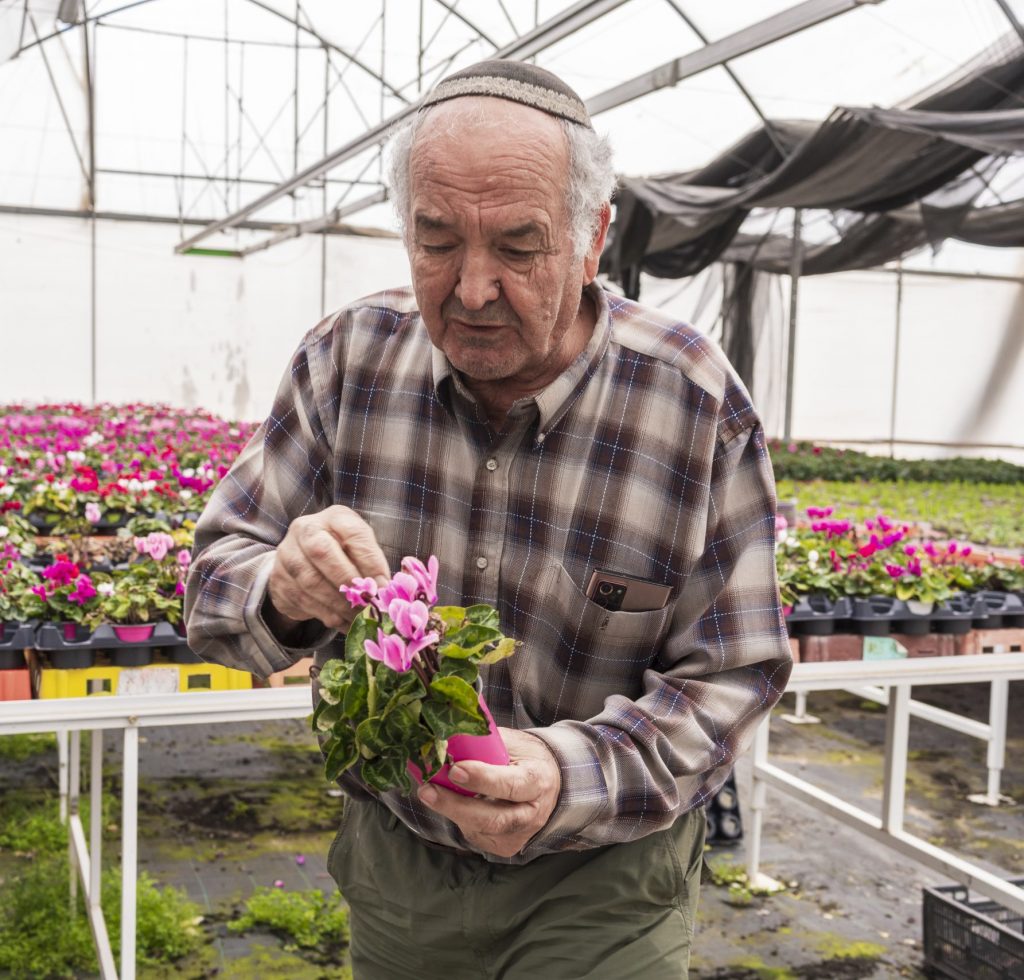
“A farmer without emunah is not a farmer.”
Assis grows his flowers in a greenhouse with a roof, on tables that are disconnected from the ground (matza menutak) and with plastic sheeting between the tables and the ground. Photo: Rebecca Kowalsky
Assaf Assis has been a farmer from the day he was born. He grew up on a moshav helping his parents raise cows and grow cotton and peanuts, only taking a break to serve in the Israeli army and study at university.
During the War of Attrition, Assis was stationed in the Sinai Desert, where he was wounded and lost a leg. Since then, he walks with a prosthesis.
His prosthesis notwithstanding, Assis is today one of the most successful growers of geraniums and other flowering plants in Israel. In the southern industrial area of Ashkelon in some eighty dunams (around twenty acres) of greenhouses, he grows about a hundred different species of flowers and plants, in a variety of colors and sizes.
As a shemitah-observant farmer, Assis grows his flowers following specific halachic guidelines. “Shemitah is a beautiful mitzvah but hard to keep in the modern world. If I stopped working entirely during shemitah, I would have to fire fifty workers,” he says.
Assis grows his flowers in a greenhouse with a roof, on tables that are disconnected from the ground (matza menutak) and with plastic sheeting between the tables and the ground, which provides a “chatzitzah,” a separation between the plants and the ground. Assis states that he always grows his flowers this way—even during a non-shemitah year.
He explains that shemitah is rooted in the idea that there shouldn’t be significant economic gaps in society. “Shemitah is not a stand-alone mitzvah. It includes shemitat karka’ot [the land rests], shemitat kesafim [monetary debts are forgiven], and yovel [after forty-nine years the land returns to its original owner].
“All these mitzvot are in order that the poor people of your town be able to eat . . . I see it as doing a ‘reset’ once in seven years,” he says.
Assis got into the flower business in 1983 when he and his wife Bracha moved to Moshav Ganei Tal in Gush Katif. All the farmers were regulated and could only grow a certain amount of crops. Regulations were even imposed on farms that produced milk, chickens and eggs, as well as on the aquaculture industry. “So I looked to grow something where I could decide how much I could grow and to whom I could sell,” he says.
Along with some others, Assis began growing geraniums, as there were fewer regulations governing the production of flowers and he could sell as much as he wanted abroad. “In the beginning I raised various types of gypsophila flowers [baby’s breath].” Eventually, there were twenty-two flower growers in Ganei Tal—flowers became one of Gush Katif’s leading agricultural products. With the destruction of Gush Katif, Assis did not allow the business he had built for over thirty years to dissolve. At his own expense, he transported hundreds of geranium plants from the Gush to the outskirts of Ashkelon, where he found land on which to rebuild his greenhouses.
Farming is not easy, admits Assis. “To be a true farmer, one needs to be connected twenty-four hours a day to the ground. You constantly walk around the area to be sure that what you are doing is good for the plants.”
And yet Assis, like the others interviewed, cannot envision doing anything else; farming is in his blood. “I have a primal love—love for the earth, the adamah. As a farmer, you see the renewal every day. One must believe that something will come from it, and we have the experience of years confirming it.”
Emunah and farming are inextricably linked, says Assis, echoing the others. “When do people begin to remember that we need Hakadosh Baruch Hu? When there is no rain. So once a year an ordinary person thinks about the rain. When you are a farmer, the little plant needs you every moment, and so every moment you think about Hakadosh Baruch Hu. Every farmer has faith deep within him. A farmer without emunah is not a farmer.”
Toby Klein Greenwald, a regular contributor to Jewish Action, is an award-winning journalist, playwright, poet, teacher, and the artistic director of a number of theater companies. She is the recipient of the Lifetime Achievement award from ATARA—The Association for Torah and the Arts for “dedication and contributions in creative education, journalism, theatre and the performing arts worldwide.”
Editor’s Note: The OU honors and appreciates the mesirut nefesh of all farmers who are observing the halachot of shemitah. As a practical matter, OU kosher-certified Israeli products and establishments do not utilize heter mechirah produce.

